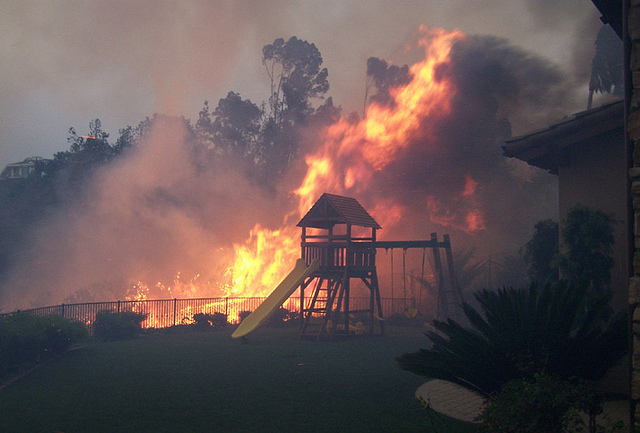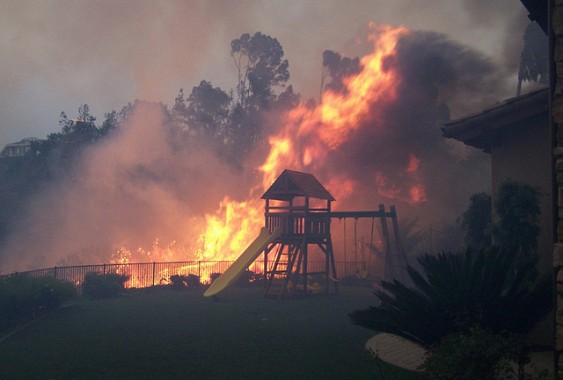How to meaningfully put the devastating wildfires raging in Colorado and elsewhere around the West into the context of climate change? Here’s my “best of” from four recent expert responses:
Dave Roberts, Grist
First up: David Roberts—always on point.
I’ve written recently about getting past the “blame” question, recommending that we instead focus on questions (and definitive answers) that are more basic and get people the info they actually need to hear (over and over): Is climate change happening? Is it caused by humans? Does it play a role in our weather? The answers here are simple and clear: yes, yes, and yes.
In Did Climate Change ‘Cause’ the Colorado Wildfires? Roberts goes deeper on the causality issue, making the distinction between proximate and distal causes of any given event. For instance, every fire has a proximate cause—a spark. The Colorado fires happened to be started by lightning. That’s their proximate cause—the most immediate and closest. But there are also a range of distal causes—the conditions or context that make something more likely.
Climate change is undoubtedly a distal cause for wildfires, but we’re not accustomed to talking about it as such, even while we’re quite comfortable pointing to a host of other distal causes. For example, Roberts points out, “When we say, ‘the fires in Colorado were caused by unusually dry conditions, high winds, and diseased trees,’ no one accuses us of error or imprecision because it was ‘really'” caused by lightning.
Roberts’ point is that talking about climate—as one among the other distal causes we reference in cases like this—is simply an unfamiliar habit. He predicts that our familiarity will grow as we witness more extreme weather.
The takeaway is that when we ask “Was it caused by climate change?” what we really want to know, Roberts writes, is “how proximate a cause climate change is, how immediate its effects are in our lives, how close it is.”
Those are the very questions to address when we talk about the conditions for these kinds of disasters created by human-caused climate change—because fires are far from abstract while climate change remains so for many. It’s a start at forming a new habit where climate is among the distal causes we’re comfortable talking about in plain terms.
Kate Yandell, New York Times
Over at NYT’s Green blog, Kate Yandell’s Pondering a Link Between Forest Fires and Climate Change does a decent job showing the link—and not merely pondering it. Interestingly, she does it mostly through distal causes (pine beetles, heat waves, drought)—and then linking those causes to climate change (a distal cause one more step removed). But, distal works here; it makes sense. After all, given just the basic information, it doesn’t really take a climate scientist or even a great detective to see the fingerprints of human-caused climate change on the wildfire crime scenes. (Emphasis mine.)
The National Climate Data Center reports that 41 heat records…have been broken or tied since Sunday, mostly in Colorado, Kansas and Nebraska, which is quite unusual for this time of year.
…
Current high temperatures are partly to blame for the early fires, but so are the low levels of precipitation this year and the lack of extremely cold nights last winter. The low snowpack and early snowmelt have made the forests dry and flammable.
Mountain pine beetle larvae have survived at higher-than-usual rates in recent years because there aren’t as many extremely cold winter nights to kill them, which has led to forests full of dry, dead trees.
The science here speaks for itself, but Yandell also gets in some “money” quotes from scientists, summing up the climate context for wildfires pretty well:
- “What we’re seeing is a window into what global warming really looks like,” said Michael Oppenheimer, a geoscientist at Princeton University. “It looks like heat. It looks like fires. It looks like this type of environmental disaster.”
- [Steven Running, a University of Montana forest ecologist] said that with human-induced climate change, extreme events will become ever more prevalent. “We’re just upping the odds that wildfire activity is going to accelerate every year with the warming trends we see,” he said.
This kind of statement boils down the science and connects it to the day’s dire news in plain terms. We need more of that from scientists and reporters alike.
Joe Romm, Climate Progress
So then there’s Joe Romm, at the ready to hold mainstream media’s feet to the fire (no pun intended). His Hell and High Water Strikes, Media Miss the Forest for the Burning Trees calls out coverage of Colorado’s fires that fails the climate context test. (These stories from ABC and PBS have been typical, “with nary a mention of global warming.”)
Romm models no-nonsense ways of making climate-weather links:
- Record-setting heat waves, wildfires, and deluges—at the same time—just what climate scientists have been forecasting for decades…The scientific literature increasingly says it’s happening now goosed on by human emissions of heat-trapping greenhouse gases.
- …global warming has “juiced” the climate, as if it were on steroids…
- …the wildfires in the west, which include the most destructive wildfire in Colorado history, are being fueled by climate change.
Goosed on. Juiced. Fueled by climate change. You can count on Romm for supplying this kind of simple soundbite and memorable metaphor. My advice: repeat often.
Climate Communication
Finally, if for whatever reason you’re not comfortable taking language from Romm’s playbook, here is the science of wildfires and climate laid out in clear and straightforward terms in Climate Communication’s excellent new report on the science of climate change and heatwaves. (Emphasis mine. Also: footnotes removed, see original for citations):
For many heat waves, there are also important [climate change] feedbacks that come into play that amplify drought and heat and set the stage for wildfires…
Some extreme examples have occurred in recent years in south Australia in January 2009, in Russia in summer 2010, and in Texas and Oklahoma in summer 2011. The record high temperatures in each case, along with the tinder dry conditions, led to extensive wildfires that were extremely costly in terms of lives, structures, human dislocations, and costs. The exceptionally warm March in the U. S. is but part of record warmth for the first five months of the year and, along with an absence of snow, the rapid snow melt has left the Rocky Mountains almost without snow by 1 June 2012. The very hot and dry conditions throughout the Southwest and Rocky Mountain Region have led to exceptionally high risk of wildfire. Multiple wildfires have already occurred, and several in Colorado and Utah have expanded into huge burn areas, resulting in loss of life and structures.
As emissions of heat-trapping gases continue to rise, and global average temperatures continue to increase, we can expect even more of the extreme heat and related impacts we’ve been witnessing in recent years.
Don’t use words like distal or proximate—although the distinction is a good one to remember. But do talk about climate as a contributing factor to take very seriously in the Colorado wildfires. It is.










